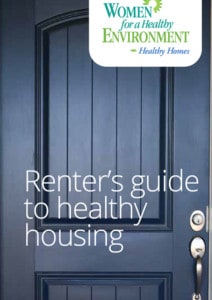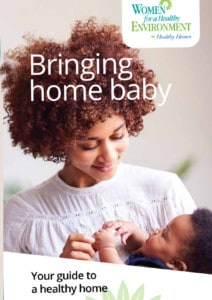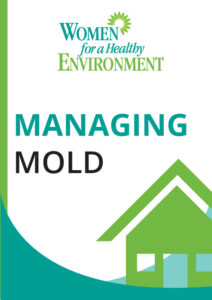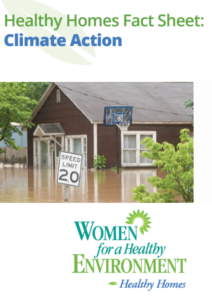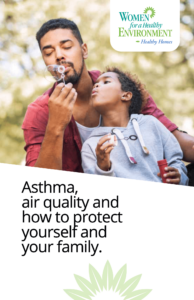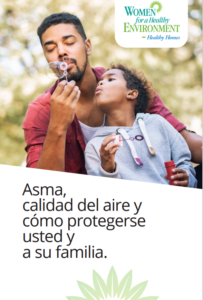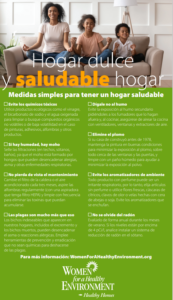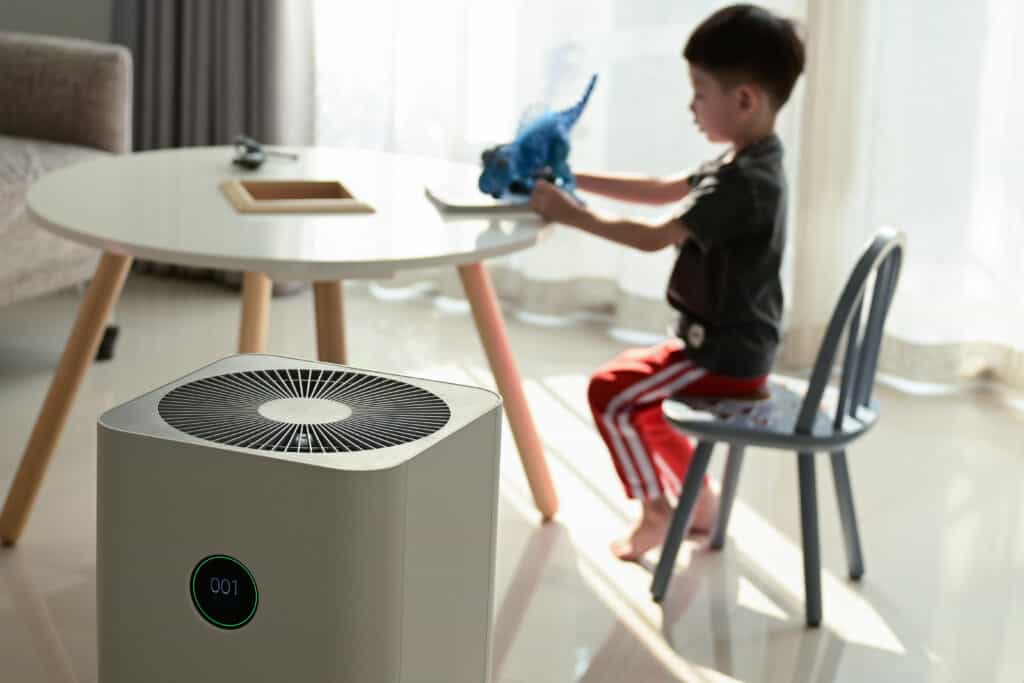
Request a Healthy Home Assessment
Our Community Health Workers (CHWs) can help you create a safer, healthier home. During a Healthy Home Assessment, a CHW will visit your home to discuss common environmental hazards like asthma and allergy triggers, lead paint, mold, and harmful chemicals. You’ll receive personalized advice on how to reduce these risks in your living space.
As part of the assessment, our CHWs provide useful resources, including:
- Green cleaning kits
- Water and air filters
- Educational materials
They can also connect you with other programs and organizations that offer support for housing-related issues and other needs you may have.
If you’d like a Healthy Home Assessment, please call our office. Wait time is currently 2-3 months.
Resource Directory
Improving Our Indoor Air Quality
Within the home, many environmental triggers can impact the quality of the air we breathe, including cleaning products, ventilation, moisture, tobacco smoke, radon, and other household products. Poor indoor air quality can be a trigger for respiratory conditions like asthma and allergies both in adults and children.

Clean Safely
- For routine cleaning of hard/non-porous surfaces, select plant-based soaps/sprays rather than petroleum-based products. You can even make your own cleaning products by using household items such as vinegar and baking soda to remove dirt and germs.
- For disinfecting hard surfaces, be sure to clean the surface first with a soap/detergent. Avoid bleach or chlorine based ready-to-use products and use hydrogen peroxide-based products for a safer alternative. Hydrogen peroxide (5-8%) or rubbing alcohol (at least 70%) can be used as a disinfectant and can be found in most stores.
Manage Pests
Everyone has to deal with unwanted critters in their home. The droppings or body parts of cockroaches and other pests can trigger asthma and/or allergic reactions. There are safer and more effective ways to deal with pests than using chemicals. Insecticides and pesticides are not only toxic to pests — they can harm people, too.
- Some pest management methods pose less of a risk:
- Keep counters, sinks, tables, and floors clean and free of clutter.
- Clean up dishes, crumbs, and spills right away.
- Store food in airtight containers.
- Seal cracks or openings around cabinets and the home’s foundation.
- Use physical controls like sticky traps for insects and snap traps for rodents.
- If after using all these methods, you may need to consider using a pesticide; choose products that limit hazards.
No Fuming
Also known as volatile organic compounds (VOCs), toxic fumes are found in paint, stains, adhesives, carpet, cosmetics, cleaning fluids, and air fresheners. Parents usually decide to paint the nursery before the baby arrives and do not realize that these paints could release VOCs, which can be harmful to parent and children’s health. Seek paints with low or no VOCs when renovating/ remodeling/repainting.
- Seek paints with low or no VOCs when renovating/ remodeling/repainting.
- Change your furnace/AC filter every three months and vacuum carpets regularly (with a HEPA vacuum).
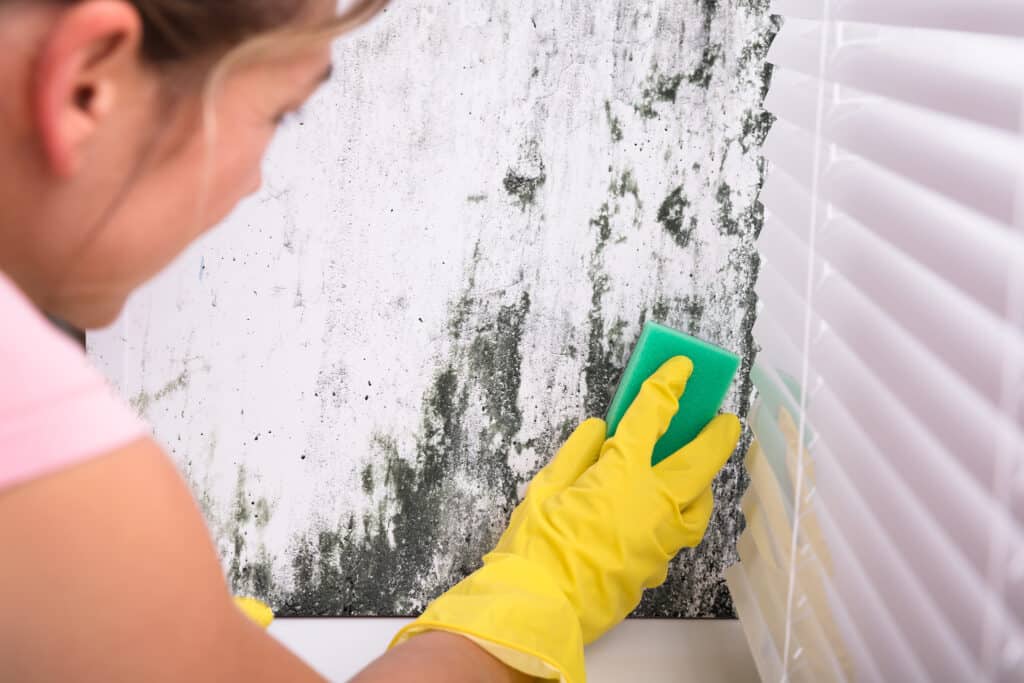
Mold Prevention
Mold grows where there is moisture, such as around leaks in roofs, windows, or pipes; condensation (e.g., warm air on cold surfaces); or where there has been a flood. Mold grows on paper, cardboard, ceiling tiles, and wood. Mold can also grow in dust, paints, wallpaper, insulation, drywall, carpet, fabric, and upholstery.
Some people exposed to damp and moldy environments can experience a stuffy nose, wheezing, red and itchy eyes or skin, while others show no symptoms at all. Individuals with mold allergies or asthma may have more intense reactions. Severe reactions can include fever and shortness of breath.
Keys to Mold Prevention
Humidity: Keep humidity levels low. An air conditioner or dehumidifier will help.
Ventilation: Increase ventilation by opening doors and windows. Use fans and bathroom exhaust fans.
Limit Carpet: Limit carpet use in bathrooms and other high moisture areas.
Repair Leaks: Repair leaks as soon as possible. Find the source of the problem first, fix it, and dry the area.
Cleaning Mold: Spray with undiluted white vinegar; wait an hour; scrub with soap and water.
Air Quality Alerts
Get updates on the Air Quality in Pittsburgh
Text “airpgh” 412-293-2922
Other Air Quality Resources
DIY Air Purifier
Watch this one minute video to learn how to make your own air purifier with just three items. Links to purchase below.
Remove Toxins

Lead
There is no safe amount of lead exposure. Lead poisoning can lead to many health impacts including brain and nervous system damage, slowed growth and development, learning and behavior problems, hearing and speech problems, and an increased risk for kidney disease, hypertension, heart disease, anemia, miscarriage, osteoporosis, stillbirths and infertility in both men and women.
It is important to recognize the sources of lead including paint/dust (in homes built before 1978), water, soil, consumer products such as glazed pottery, toys, and some spices. Certain hobbies including hunting and fishing and some occupational exposures including the automotive industry, can put people at risk for lead exposure.
Allegheny County Safe and Healthy Homes
- Allegheny Lead Safe Homes Program: FREE lead paint testing and home repairs for families who fulfill specific requirements. Homeowners, tenants and landlords can all apply. Landlord and tenant must both be in an agreement to program guidelines. Eligibility requirements include property location and age, homeowner or renter in Allegheny County, presence of a child younger than 6, presence of lead hazard and income. Email or contact 412-227-5700 to apply.
- Allegheny County Health Department Home Lead Investigations: If your child’s confirmed blood lead level is at or above 5 ug/dl, ACHD’s Housing and Community Environment Program will contact your family and offer a free voluntary lead-based paint investigation to identify potential sources of lead exposure in your home. Contact the Housing program at 412-350-4046 to learn more.
Get the Lead Out, Pittsburgh
Get the Lead Out, Pittsburgh is a public awareness campaign designed to shine a light on lead poisoning in Allegheny County, help families who are impacted by lead poisoning, and enact changes to make our community safer.
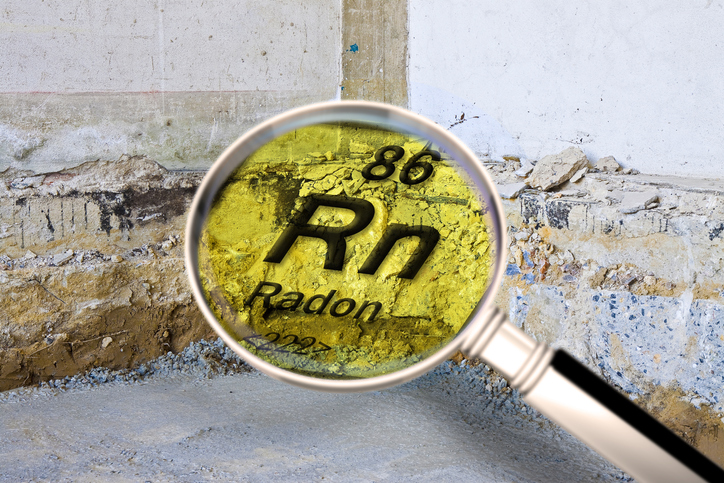
Radon in Pennsylvania
Pennsylvania has one of the most serious radon problems in the United States. Approximately 40% of homes have radon levels above the Environmental Protection Agency’s action guideline of 4 picocuries per liter. Search for radon test data by zip code and learn more about radon exposure in Pennsylvania.
Radon is a radioactive gas found in many buildings, including schools, homes and offices. The breakdown of uranium in soil, rocks and water forms radon’s radioactive gas. Radon exposure is the second leading cause of lung cancer deaths in the United States, second only to smoking. The ideal time for radon testing in the home is during late fall and winter months.
Radon Testing Kits
The American Lung Association and the Pennsylvania Department of Environmental Protection are working together to provide radon test kits to Pennsylvania residents who have not yet tested their homes for dangerous radon gas.
Visit their website to request a free kit.

Consumer Product Safety
The more you understand the products you buy and bring into your home, the healthier your home will be.
Baby Products: Many infant and child personal care product brands have natural lines, but buyers beware that these products may still contain toxic chemicals. Choose products that are plant-based and have the fewest and safest ingredients. When selecting feeding items such as baby bottles and sippy cups, choose products that are PVC, BPS, and BPA free.
Remember, don’t expose your baby to products such as nail polish and makeup; they will have time for that as they get older.
Formula: It is not always possible to breastfeed, or a mother may have to supplement with formula. The American Academy of Pediatrics currently recommends that you seek iron-fortified formula for all infants who are not breastfed, and use filtered water when preparing it. Make sure to use an NSF-certified filter to remove the lead from the tap water. If you cannot filter your water, be sure to always use cold tap water when preparing formula or cooking food.
Cribs, Bedding, and Blankets: It is not always possible to breastfeed, or a mother may have to supplement with formula. The American Academy of Pediatrics currently recommends that you seek iron-fortified formula for all infants who are not breastfed, and use filtered water when preparing it. Make sure to use an NSF-certified filter to remove the lead from the tap water. If you cannot filter your water, be sure to always use cold tap water when preparing formula or cooking food.
Children’s Toys: Beware of toys that contain toxic plastic softeners (phthalates), PVC (#3 plastics), and fragrances. When you’re not quite sure, avoid soft plastics that have a strong plastic smell (think rubber ducky). Also, be cautious of imported or antique toys that may contain toxic lead paint.
When buying a toy, look for items that are made from wood or cloth. If a toy can be reused (like a dollhouse or play set), then purchase a higher quality item.
Labels that say “eco-friendly” and “natural” are marketing terms, not legal standards. When buying personal care products for your baby, read the labels and avoid products that contain fragrance, parabens, phthalates, and triclosan.
Concerned your child’s toy may have lead in it? Contact us to conduct a toy test.
Flooring: Many infant and child personal care product brands have natural lines, but buyers beware that these products may still contain toxic chemicals. Choose products that are plant-based and have the fewest and safest ingredients. Remember, don’t expose your baby to products such as nail polish and makeup; they will have time for that as they get older.

Green Cleaning
Asthma Action Kits
We distribute free asthma-friendly green cleaning buckets to reduce allergens, and breathing triggers and safely address pests and mold in the home. Each kit contains (1) 12-quart bucket, (1) 24-ounce empty spray bottle, (1) 16-ounce white vinegar, (1) 1-lb box of baking soda, (1) microfiber cloth, and (1) cockroach bait trap.
Heavy Metal Testing in Household Goods
Within 30 seconds we can test cosmetics, dishware, jewelry, toys, paints, and many more commonly used consumer products for the presence of lead, mercury, arsenic, and cadmium and determine if they are safe for you and your family to continue using or provide advice on what to do if they pose a dangerous risk.
Water filters & water quality
WHE will distribute free water filters to any household with a child present in the Pittsburgh Water and Sewer Authority (PWSA) service area. We typically distribute water filters during community workshops so residents may have the opportunity to discuss water quality issues. Brand: ZeroWater Pitcher
For Renters

Understanding Tenant’s Right to a Habitable Home
As a tenant, you are entitled to live in an environment both safe and habitable. It is important to understand what your rights are and how you can work with your landlord to maintain a healthy and safe space. The implied warranty of habitability applies in all cases where someone is renting a place to live — whether a house, apartment, mobile home or lot in a mobile home park. It applies whether you have a written lease or an oral agreement with a landlord. The warranty is so important, it is in effect whether or not you and the landlord have specifically agreed to it. It cannot be given up (waived).
Under State Law
A landlord must make repairs necessary to keep your home in a safe, sanitary, and healthy condition, provided you as a tenant did not cause the problem and provided you are current on your rent when the problem(s) develop.
This includes only serious defects such as:
- Leaking roof
- Dangerous wiring
- Broken floor
- Lack of water
- Infestations
If the landlord does not make repairs, the tenant has the right to repair and deduct the repair cost from future payments to the landlord.
How to Assert Your Right to a Habitable Home
How to Assert Your Right to a Habitable Home Try to work the problem out with your landlord in a way that’s fair to both of you. If that doesn’t work, then you should:
Step 1: Tell the landlord about the problem. Tell your landlord, in writing, what the problem is and what you plan to do about it. Keep a copy of the letter to prove that the landlord was notified. Your letter should describe the problem(s), ask the landlord to fix it, and say what you will do if it is not fixed within a reasonable time.
Step 2: Allow your landlord time to repair. The law gives your landlord a reasonable amount of time to make the repairs. The amount of time depends on the seriousness of the defect. The more serious the problem, the sooner it should be fixed. Emergencies such as lack of heat in winter should be fixed very promptly.
Step 3: Collect evidence to show that the landlord did not make repairs. You want to be able to show the judge what the problem was, that you gave the landlord notice, and that the problem was not fixed within a reasonable time. A copy of the letter sent to the landlord can be used as evidence, as can pictures, witnesses, or the report of a housing code inspector. If repairs are needed, it is also helpful to get a contractor, plumber, or electrician to give you an estimate to repair the problem(s), if possible.
Actions to Consider
What If the Landlord Does Not Fix the Problem?
Every case is different. Depending on the special facts in your particular case, you may be able to do the following:
Withhold rent: Reduce the amount of rent that you pay, because of the problem. The amount you should hold back depends on how bad the problem is—the worse the problem, the more rent you may withhold. It is a good idea to keep the rent that you withhold in a separate bank account, so that you can pay the money later if a court decides you owe rent. Then, if your landlord tries to evict you and the judge rules that the housing conditions were not as bad as you thought, you will be able to pay the rent the judge says you owe.
Repair & deduct: Repair the defect yourself or have a professional repair it and deduct the cost from your rent payments. The repairs must be necessary to make the home safe and livable and must be reasonable in price. Get a signed receipt. When your rent comes due, give your landlord a copy of the receipt and pay the difference between your rent and the cost of the repairs. The cost of the repairs cannot be more than the amount of rent you owe for the lease term—for example, if you have a month-to-month lease, the repairs cannot cost more than one month’s rent.
Bring a lawsuit: Legal aid may be available to get back the rent you paid when your home was not fit or to get compensation for any injuries or other damages you suffered because of the landlord’s failure to make repairs.
Get a court order: A court order will require the landlord to make repairs. The Community Justice Project provides legal guidance on tenant rights. There are certain standards under habitability requiring landlords and property owners to maintain their properties.
Move out: If you move out, write to your landlord to provide your moving date and notify him/her you are moving because the housing conditions were not repaired. You should only use this option if the unit is totally unlivable. Your landlord may sue you for all the rent remaining due on the lease, so you must be able to show you had no other alternative.
Contact code enforcement: Your landlord must obey any housing code which covers the place where you live. In some cases, the local code enforcement officer can make the landlord fix the problem, or at least help prove the problem really exists. The same is true for the Health Department.
Contact your local government to see if help is available.

Tenant & Housing Resources
ACTION Housing is Pittsburgh’s largest non-profit developer, they exist to help people improve their lives by offering quality, affordable housing. ACTION has operated the Weatherization Assistance Program for the City of Pittsburgh, Allegheny, Washington, and Greene Counties for 25+ years.
Rebuilding Together Pittsburgh provides low- income homeowners with critical home repairs, accessibility modifications and energy-efficient upgrades.
- Neighborworks Financial Wellness and Homeownership Resources
- Community Justice Project Lead Contamination & Housing Legal Representation
- Urban League of Greater Pittsburgh Financial Toolkit and Resources for Financial Wellness
- Urban Redevelopment Authority Resources for Homeowners.
- Fair Housing Law Center Housing Discrimination Law
- Neighborhood Legal Services: Understanding Tenant Protections and Tangled Title Help
- Allegheny County Health Department: Filing a Housing Code Violation
- LawHelp Interactive Sample Letters to Landlords

